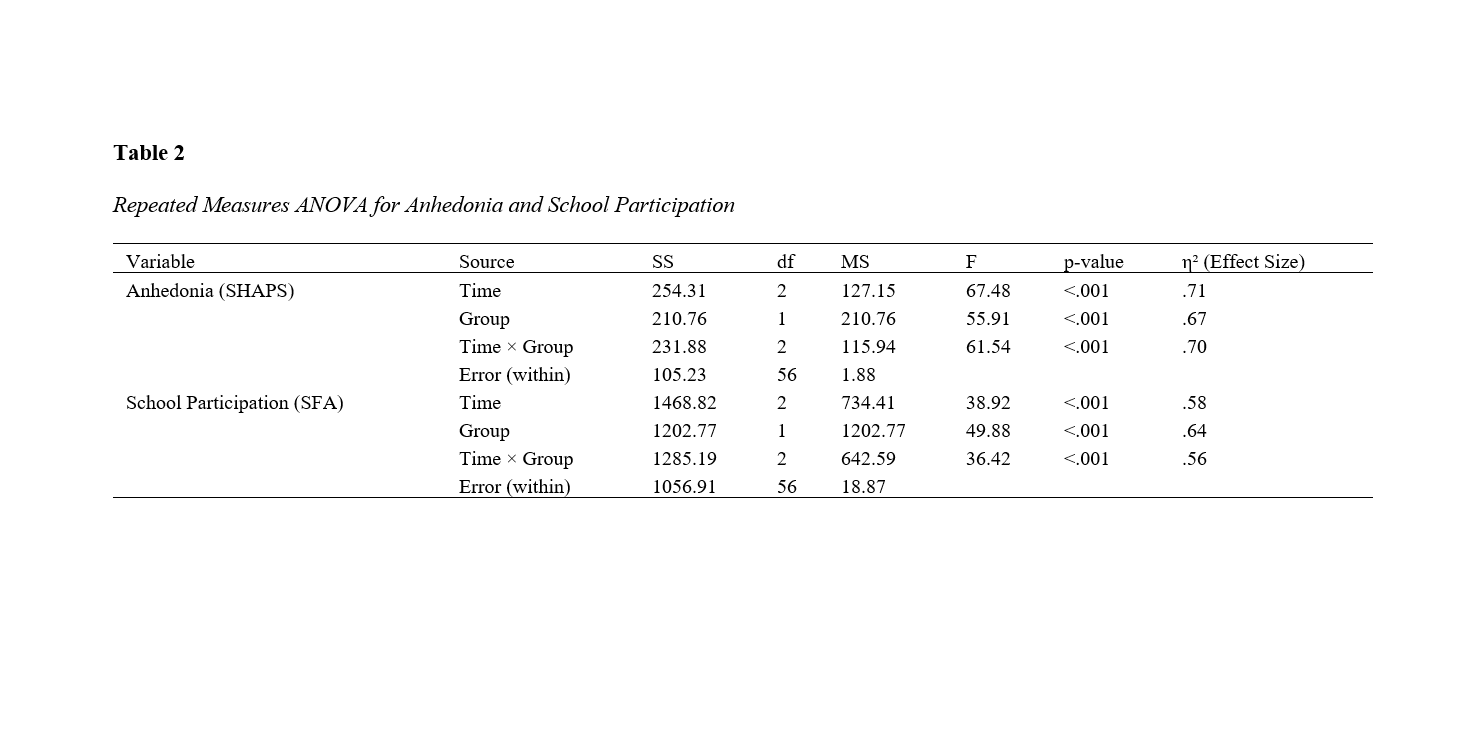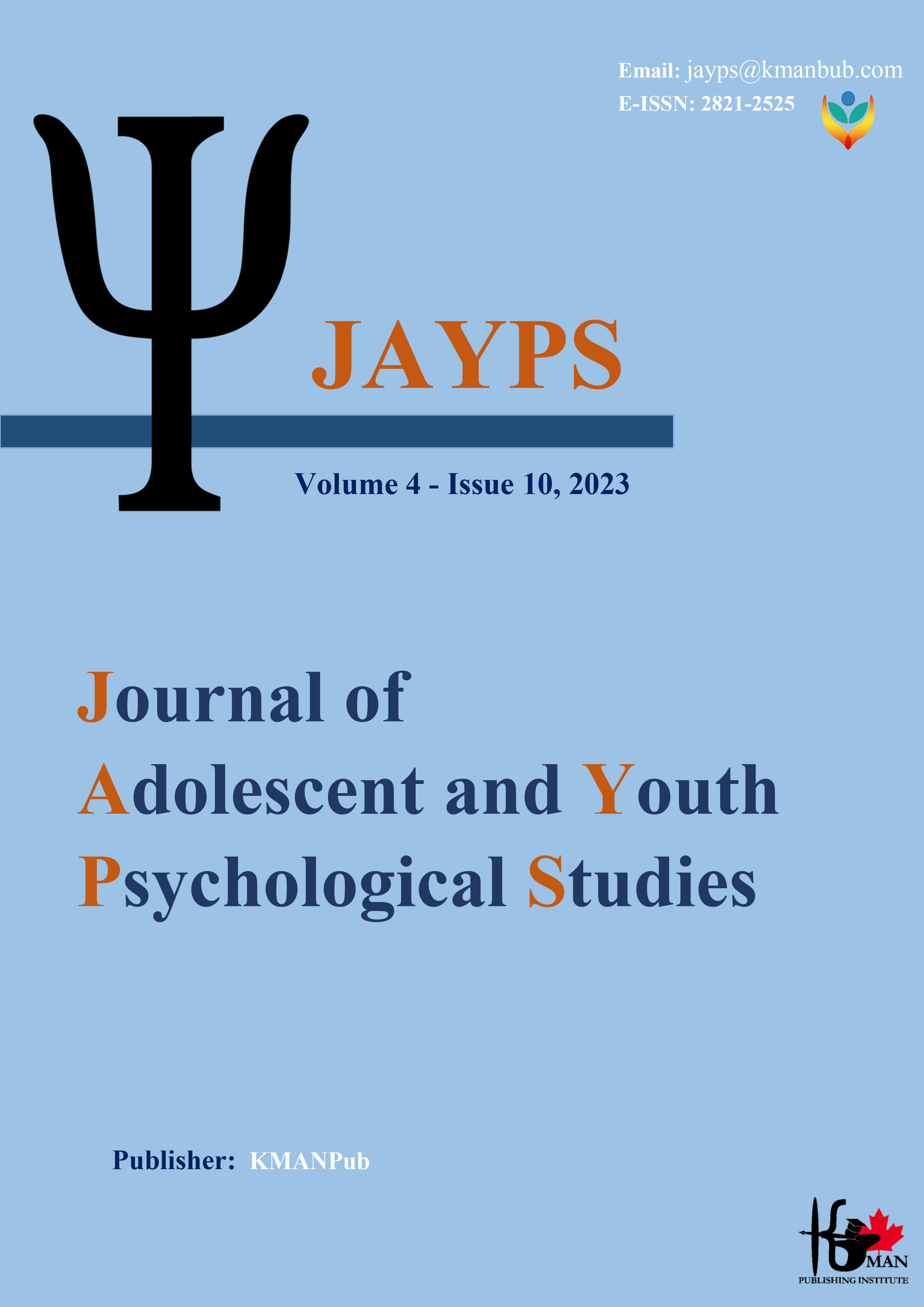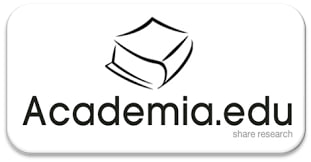Effectiveness of Behavioral Activation Therapy on Anhedonia and School Participation
Keywords:
Behavioral Activation Therapy, Anhedonia, School Participation, Adolescents, Randomized Controlled Trial, MalaysiaAbstract
Objective: This study aimed to evaluate the effectiveness of Behavioral Activation Therapy (BAT) on reducing anhedonia and enhancing school participation among adolescents in Malaysia.
Methods and Materials: A randomized controlled trial design with a five-month follow-up was used, involving 30 adolescents randomly assigned into intervention and control groups (n = 15 each). The intervention group received 12 weekly sessions of Behavioral Activation Therapy, each lasting 45–60 minutes, targeting increased participation in rewarding and meaningful activities. The control group received no intervention during the study period. Anhedonia was measured using the Snaith–Hamilton Pleasure Scale (SHAPS; Snaith et al., 1995), and school participation was assessed by the School Function Assessment (SFA; Coster et al., 1998) at pre-test, post-test, and five-month follow-up. Repeated measures ANOVA with Bonferroni post-hoc tests were performed using SPSS-27.
Findings: Repeated measures ANOVA demonstrated significant improvements in the intervention group on both anhedonia (F(2, 56) = 61.54, p < .001, η² = .70) and school participation (F(2, 56) = 36.42, p < .001, η² = .56). Mean anhedonia scores in the intervention group significantly decreased from pre-test (M = 10.47, SD = 1.36) to post-test (M = 5.13, SD = 1.21) and remained stable at follow-up (M = 5.20, SD = 1.33). Similarly, school participation significantly increased from pre-test (M = 56.27, SD = 6.84) to post-test (M = 72.40, SD = 5.92), with effects sustained at follow-up (M = 71.53, SD = 6.15). Post-hoc comparisons confirmed that all significant changes occurred between pre-test and post-test, with stability from post-test to follow-up.
Conclusion: Thes findings suggest the therapy suitability as an effective therapeutic approach within educational and psychological practice settings.
Downloads
References
Aldagamseh, B. I. M. (2023). Attitudes of Physical Education Teachers Towards the Participation of Students With Disabilities in the Physical Education Class in Schools. International Journal of Membrane Science and Technology, 10(3), 1447-1454. https://doi.org/10.15379/ijmst.v10i3.1726
Bao, S., Liu, J., & Liu, Y. (2022). Shedding Light on the Effects of Orienteering Exercise on Spatial Memory Performance in College Students of Different Genders: An fNIRS Study. Brain Sciences, 12(7), 852. https://doi.org/10.3390/brainsci12070852
Bowins, B. (2020). Behavioral Activation Therapy. 181-198. https://doi.org/10.1016/b978-0-12-819625-0.00008-3
Claudia, C., & Setiawan, E. (2021). The Influence of Emerging Adulthood Status and Sensation Seeking on Financial Behavior of Petra Christian University Students. International Journal of Financial and Investment Studies (Ijfis), 1(2), 94-100. https://doi.org/10.9744/ijfis.1.2.94-100
Domínguez-Rodríguez, A., Martinez-Maqueda, G. I., Landgrave, P. A., Martínez-Luna, S. C., Ramírez-Martínez, F. R., & Saldivar, J. T. S. (2020). Effectiveness of Behavioral Activation for Depression Treatment in Medical Students: Study Protocol for a Quasi-Experimental Design. Sage Open Medicine, 8. https://doi.org/10.1177/2050312120946239
Hershenberg, R., Mavandadi, S., Wright, E., & Thase, M. E. (2017). Anhedonia in the daily lives of depressed Veterans: A pilot report on experiential avoidance as a moderator of emotional reactivity. Journal of affective disorders, 208, 414-417. https://doi.org/10.1016/j.jad.2016.10.011
Knoster, K. C., & Myers, S. A. (2020). College Student Perceptions of Frequency and Effectiveness of Use of Relevance Strategies: A Replication and Extension. Communication Studies, 71(2), 280-294. https://doi.org/10.1080/10510974.2020.1720260
Latifah, U., & Hasanah, I. (2024). The Role of Student Management in Implementing Religious Development Activities at MTs Nurul Islam Kota Kediri. Ijomer, 2(1). https://doi.org/10.30762/ijomer.v2i1.2761
Lyu, J., Shepherd, D., & Lee, K. (2023). The Effectiveness of University Entrepreneurship Activities on Student Start-Up Behavior. 161-204. https://doi.org/10.1108/s1074-754020230000023009
Maajeeny, F. S. (2021). The Effect of Activity Schedules to Teach Appropriate Activities During Free Time to Students With Autism Spectrum Disorders. European Journal of Special Education Research, 7(1). https://doi.org/10.46827/ejse.v7i1.3574
Mattson, S. L., & Pinkelman, S. E. (2019). Improving on-Task Behavior in Middle School Students With Disabilities Using Activity Schedules. Behavior Analysis in Practice, 13(1), 104-113. https://doi.org/10.1007/s40617-019-00373-2
Mori, T., Aoki, T., Oishi, K., Harada, T., Tanaka, C., Tanaka, S., Tanaka, H., Fukuda, K., Kamikawa, Y., Tsuji, N., Komura, K., Kokudo, S., Morita, N., Suzuki, K., Watanabe, M., Kasanami, R., Hara, T., Miyazaki, R., Abe, T., . . . Ishii, K. (2024). Relative Age Effect on the Physical Activity and Sedentary Behavior in Children and Adolescents Aged 10 to 18 Years Old: A Cross-Sectional Study in Japan. https://doi.org/10.21203/rs.3.rs-4937775/v1
Nurlaela, N., Amiruddin, A., Irfan, A., & Setialaksana, W. (2024). Communication Anxiety as Barrier: Extending Theory of Planned Behavior on Student Intention to Participate in Synchronous Online Learning. Information and Learning Sciences, 125(11/12), 966-985. https://doi.org/10.1108/ils-10-2023-0136
Putri, W. D., Fontanella, A., & Handayani, D. (2023). Pengaruh Penggunaan Financial Technology, Gaya Hidup Dan Pendapatan Orang Tua Terhadap Perilaku Keuangan Mahasiswa. Akuntansi Dan Manajemen, 18(1), 51-72. https://doi.org/10.30630/jam.v18i1.213
Sabrina, B. C. S. (2024). Financial Literacy, Lifestyle, Self-Control on Students' Financial Behavior. Ijmbs, 3(02), 87-98. https://doi.org/10.31942/ijmbs.v3i02.12371
Salim, Z. A. A. (2023). Investigating the Predictors of Physical Activity Behavior Among Female College Students in Saudi Arabia Using the Theory of Planned Behavior. Physical Education of Students, 27(5), 270-278. https://doi.org/10.15561/20755279.2023.0507
Takagaki, K., Okamoto, Y., Jinnin, R., Yokoyama, S., Yoshino, A., Kagawa, F., Okamoto, Y., Miyake, Y., & Yamawaki, S. (2018). Effects of Behavioral Activation Program Without Psychotropic Medication Treatment for Depression in Late Adolescence: Case Report. Neuropsychiatric Disease and Treatment, Volume 14, 2159-2164. https://doi.org/10.2147/ndt.s168077
Tanglao, R. S. (2021). Behavior in Sports Activity Amidst Pandemic of Student-Athletes of Lyceum of the Philippines University, Cavite. Epra International Journal of Research & Development (Ijrd), 254-270. https://doi.org/10.36713/epra7461
Wachsmuth, S. T., Lewis, T. J., & Gage, N. A. (2023). Exploring Extracurricular Activity Participation, School Engagement, and Social Competence for Students With Emotional and Behavioral Disorders. Behavioral Disorders, 48(4), 255-268. https://doi.org/10.1177/01987429231166675
Walsh, E. C., Eisenlohr-Moul, T. A., Minkel, J., Bizzell, J., Petty, C., Crowther, A., Carl, H., Smoski, M. J., & Dichter, G. S. (2019). Pretreatment brain connectivity during positive emotion upregulation predicts decreased anhedonia following behavioral activation therapy for depression. Journal of affective disorders, 243, 188-192. https://doi.org/10.1016/j.jad.2018.09.065
Wang, J., & Li, Q. (2023). Promoting Effects of the Exercise Behavioral Ecological Model on Physical Activity Behaviors of Students. American Journal of Health Behavior, 47(1), 109-115. https://doi.org/10.5993/ajhb.47.1.12
Wang, W. (2025). The Mediating Role of Behavioral Systems in Linking Physical Activity and Anxiety Symptoms in College Students. Scientific reports, 15(1). https://doi.org/10.1038/s41598-025-91294-4
Yang, H., Wang, S., Chen, X., Zhang, H., & Wong, C. U. I. (2025). Does Participation in Group Music Activities and Pro-Social Behavior Among College Students Have an Association? A Study of the Interlocking Mediating Effects of Positive Social Connections and Peer Support. Behavioral Sciences, 15(1), 64. https://doi.org/10.3390/bs15010064
Yang, J., & Seyed Alitabar, S. H. (2024). The Effects of School Size on Student Participation and Sense of Community [Research Article]. Iranian Journal of Educational Sociology, 7(1), 205-211. https://doi.org/10.61838/kman.ijes.7.1.20
Yue, Y. (2024). Exploring Role of Physical Activity and Emotional Exhaustion to Improve Preventive Health Behavior Among Students of Chinese Colleges. American Journal of Health Behavior, 48(6), 1692-1701. https://doi.org/10.5993/ajhb.48.6.20
Zhuan, S., Cao, J., Ye, Y., Li, H., Zhang, Q., & Wang, X. (2024). The Relationship Between Physical Activity and Procrastination Behavior Among Chinese University Students: A Chain Mediated Effect of Body Self-Esteem and Overall Self-Esteem. Frontiers in Public Health, 12. https://doi.org/10.3389/fpubh.2024.1434382

Downloads
Additional Files
Published
Submitted
Revised
Accepted
Issue
Section
License

This work is licensed under a Creative Commons Attribution-NonCommercial 4.0 International License.








